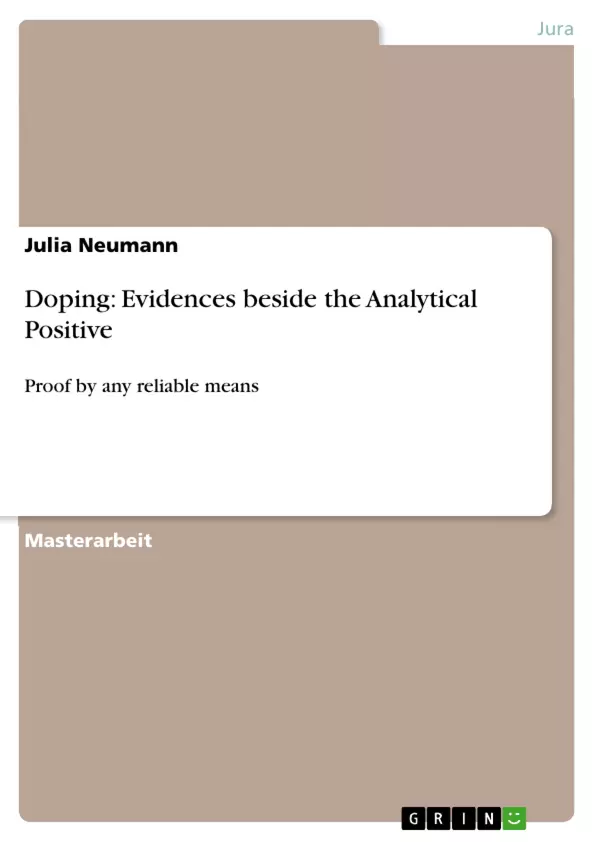Unfortunately, sport nowadays does not always meet the idealized image of a clean competition. In too many cases, illegal performance enhancement, so called “doping”, plays a dominant role in sports. This development might derive from the circumstance that sport is rather a business than an individual endeavour and self-realisation. Enormous amounts of money are involved in hosting events and marketing of athletes. However, increased doping actions may also result from the development and availability of various technical possibilities for performance enhancement.
In the rather widespread field of doping, this paper focuses on the specific area of evidences on doping rule violations other than by so called “analytical positives”. This paper concentrates on circumstantial, non-analytical and evidence by longitude profiling. Concluding from the number of decisions, these forms of evidence play an important role in the conviction of doping infractions.
Circumstantial evidences, for example, inhabit crucial importance in cases where an analytical sample is not available. This refers to cases where, for instance, a doping offence is detected some time later and to cases where, with present laboratory techniques, the use of a substance or method in general is hard/ impossible to detect. Especially in the latter case, methods like longitude profiling of blood/urine may be more widely used in the long term.
However, in non-analytical cases, authorities have to face the challenge that the principle of strict liability is not applicable, as in cases where the use of a prohibited substance is proven by the positive result of analytical laboratory tests. In this circumstance, strict liability means that the proof of knowledge or intent to use the substance is redundant. Furthermore, questions arise when the burden of proof is fulfilled in case of a doping allegation, and when non-analytical and/or circumstantial evidences amount to a conviction. Partially, the referring answer is dependent on the distinction between the system of criminal law and classification of disciplinary rules as part of public law.
This paper will deal with these issues raised above standing. It will furthermore provide a critical analysis of selected decisions made by the International Court of Arbitration for Sport based on these special types of evidence. The paper, finally, will summarize difficulties and inconsistencies throughout the decisions, but also confirmations and similarities.
Inhaltsverzeichnis
- Chapter 1: Introduction to Doping and Ethical Aspects on Performance Enhancement
- Chapter 2: Types of Evidence: Analytical and Non-Analytical Methods.
- A. Analytical Evidence, the Positive and Strict Liability.
- B. Non-Analytical Evidence
- I. Variety of Proofs
- II. Lack of Strict Liability.
- C. Distinction of Direct and Circumstantial Evidence
- Chapter 3: Analysis of Non-Analytical and Circumstantial Evidence Cases
- A. Standard of Proof
- B. Use of a Prohibited Substance or Method
- I. Case Montgomery and Gaines
- II. Case French
- III. Case Pechstein
- C. Trafficking and Possession
- I. Case Wyper.
- II. Case Troy.
- III. Case Marinov
- D. Attempt
- I. Case Wyper..
- II. Case Troy..
- III. Case Gibilisco
- Chapter 4: Conclusion
Zielsetzung und Themenschwerpunkte
Diese Arbeit untersucht die Beweismittel für Dopingverstöße, die über den Nachweis eines positiven analytischen Befundes hinausgehen. Dabei konzentriert sich die Arbeit auf indirekte, nicht-analytische Beweise und Beweise aus Längsprofilanalysen.
- Der Bedeutung von nicht-analytischen Beweisen in Fällen, in denen keine analytischen Proben verfügbar sind.
- Die Unterscheidung zwischen direktem und indirektem Beweismaterial.
- Die Schwierigkeiten bei der Anwendung des Prinzips der strikten Haftung in nicht-analytischen Fällen.
- Die Analyse von ausgewählten Fällen und Entscheidungen des Internationalen Sportgerichtshofs (CAS) basierend auf diesen besonderen Beweisarten.
- Die Herausforderungen und Unstimmigkeiten bei der Anwendung von nicht-analytischen Beweisen in Dopingverfahren.
Zusammenfassung der Kapitel
Kapitel 1: Diese Einführung beleuchtet den Kampf gegen Doping und die ethischen Aspekte der Leistungssteigerung im Sport. Es wird die Definition von Doping im Sinne der Welt-Anti-Doping-Agentur (WADA) vorgestellt und die Kriterien für die Einordnung von Substanzen oder Methoden als verboten erläutert.
Kapitel 2: Dieses Kapitel befasst sich mit verschiedenen Beweisarten im Dopingkontext, wobei die Unterscheidung zwischen analytischen und nicht-analytischen Methoden im Vordergrund steht. Es werden die Prinzipien der strikten Haftung im Zusammenhang mit analytischen Befunden sowie die Herausforderungen bei der Anwendung des Prinzips in nicht-analytischen Fällen erörtert.
Kapitel 3: Dieses Kapitel analysiert verschiedene Fälle, die auf nicht-analytischen und indirekten Beweisen beruhen. Es werden wichtige Entscheidungen des CAS in Bezug auf den Standard des Beweises, den Nachweis der Verwendung einer verbotenen Substanz oder Methode, den Handel und den Besitz sowie den Versuch einer Doping-Verfehlung betrachtet.
Schlüsselwörter
Die wichtigsten Schlüsselwörter und Themen der Arbeit sind Doping, nicht-analytische Beweise, indirekte Beweise, Längsprofilanalyse, Beweisstandard, strikte Haftung, Internationale Sportgerichtshof (CAS), Doping-Verstöße, Leistungssteigerung, Ethik im Sport, Fairplay, World Anti-Doping Agency (WADA).
- Quote paper
- Julia Neumann (Author), 2010, Doping: Evidences beside the Analytical Positive, Munich, GRIN Verlag, https://www.grin.com/document/163108



